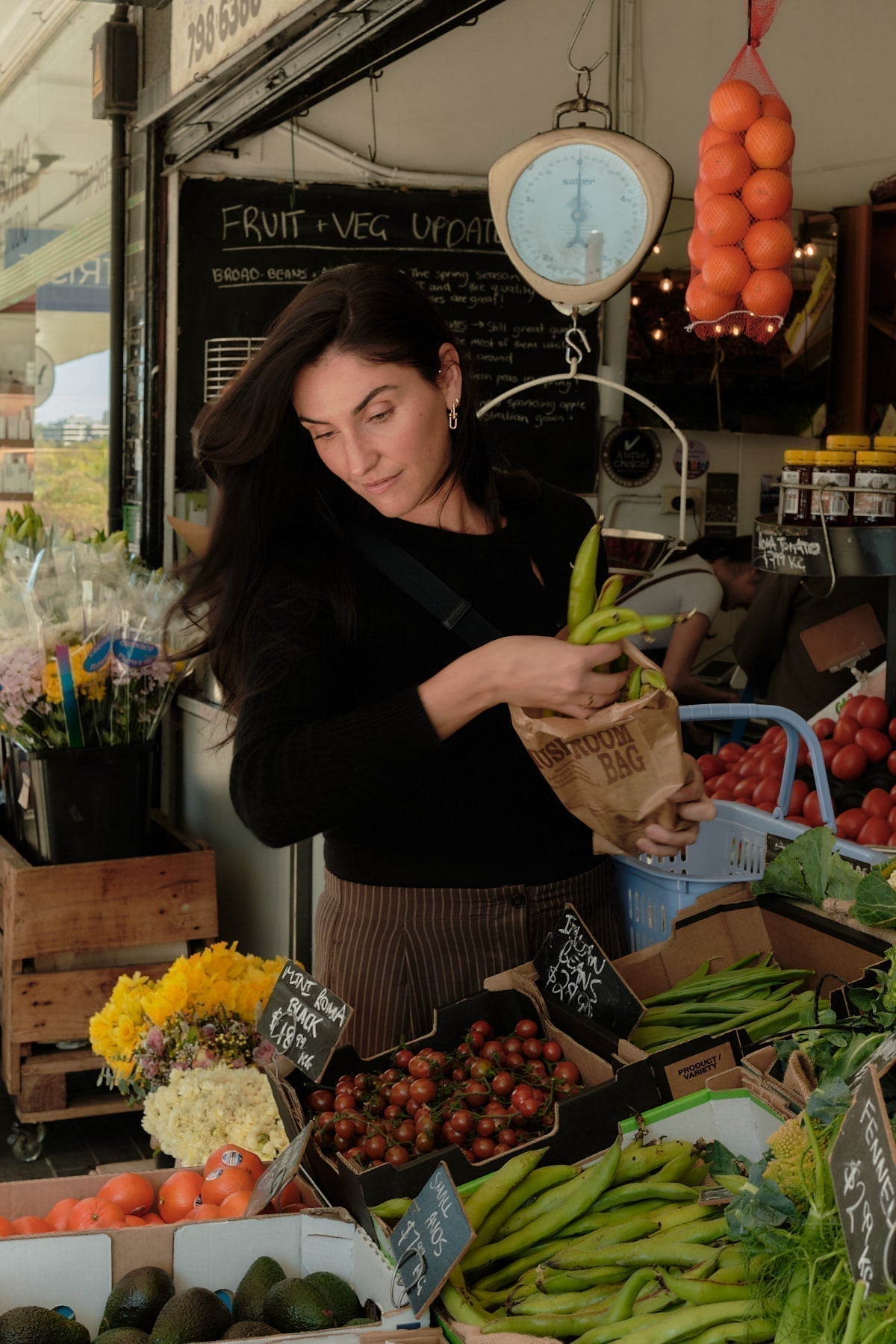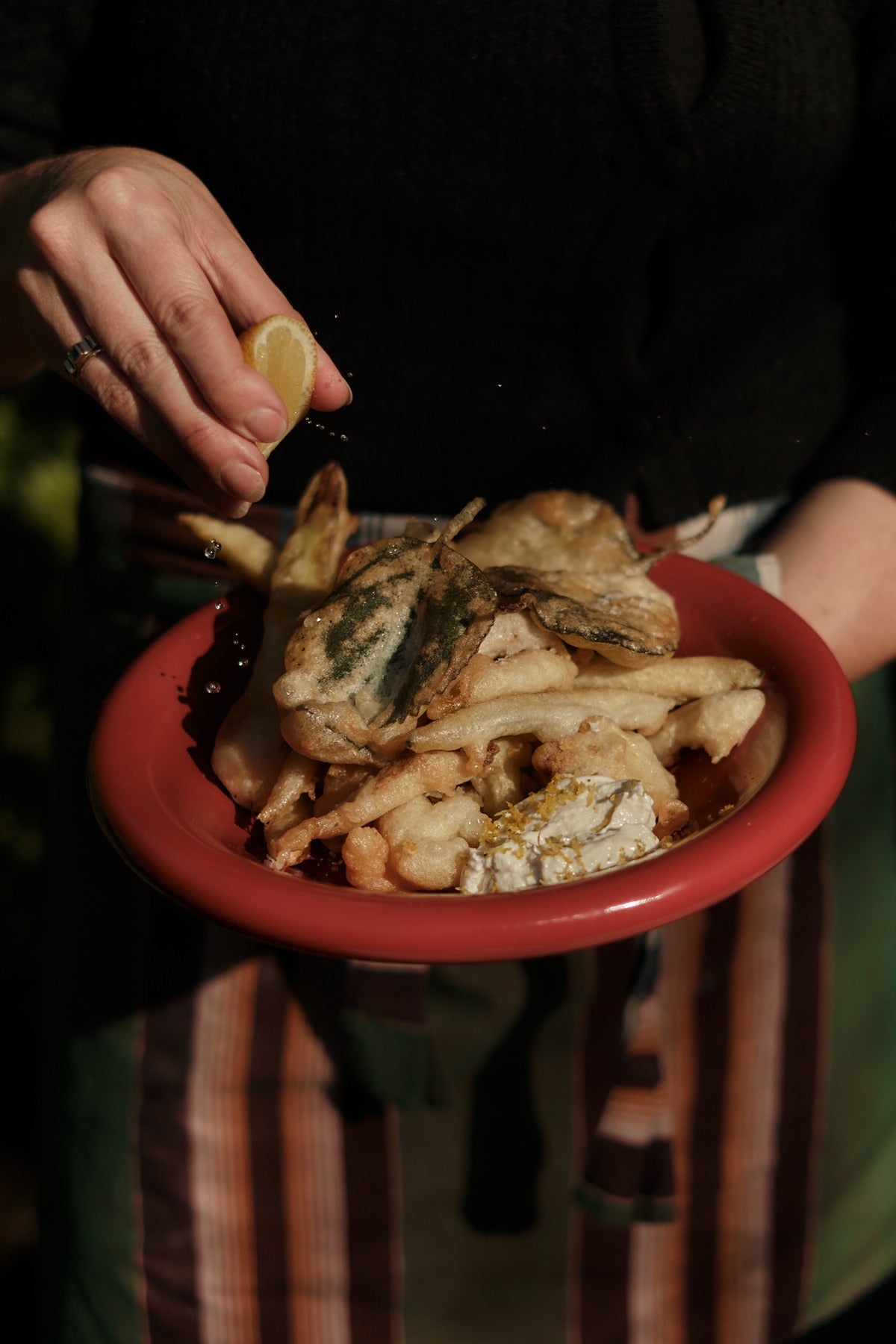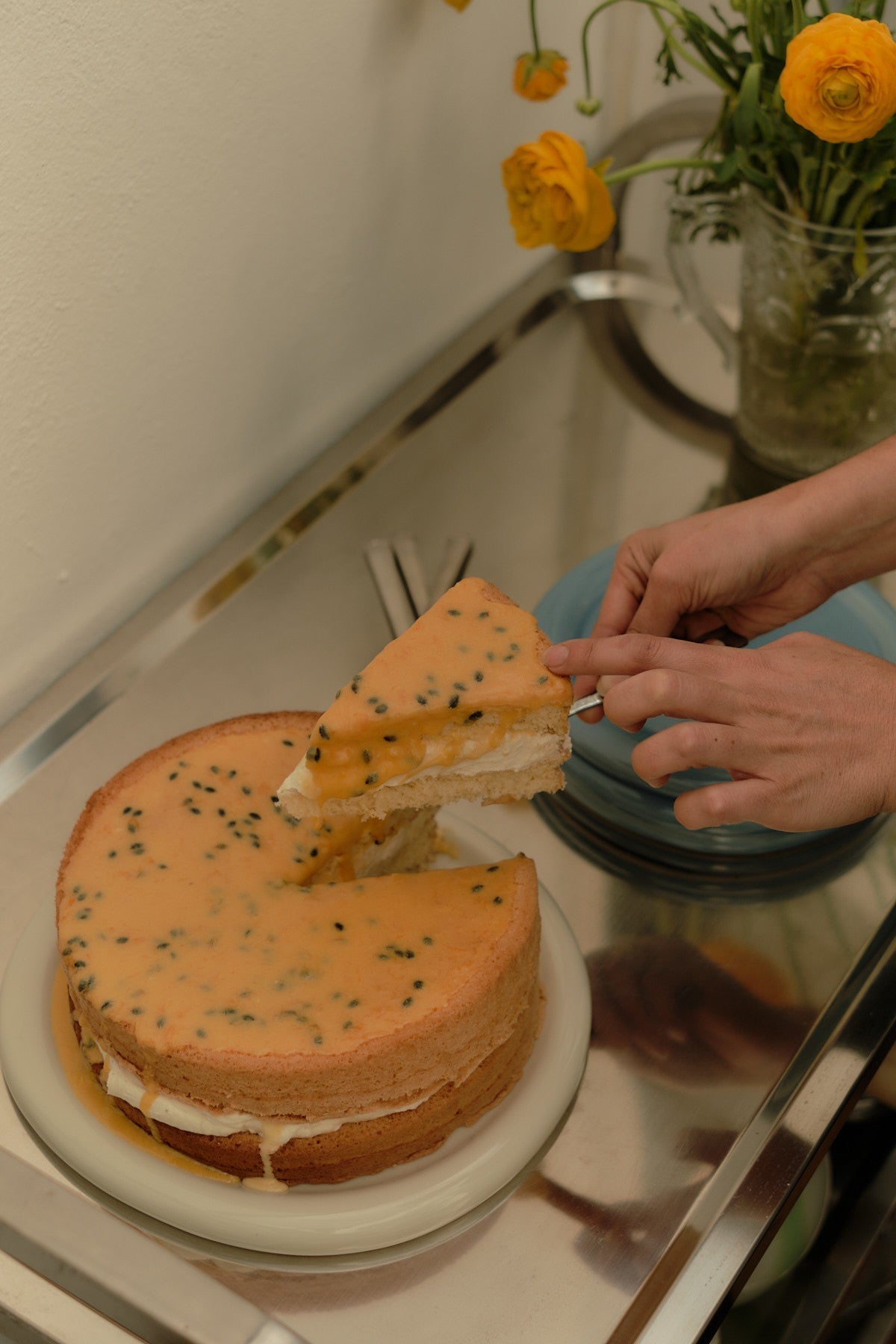
Creativity was always present, woven into the everyday. It felt natural to express myself through making, styling, and imagining—it was both an innate need and a means of escape.

-
LC:Spending the day with you, it’s clear how naturally food and design fold into one another. I want to step back, though—back to when you were a kid. You grew up between Victoria and Perth, with an architect father and two very creative women at home. What do you remember about that time, and how do you think it shaped the way you see and create today?
-
SR:Before moving to Perth in mid-primary school, I spent my early years in Victoria, with my parents living separately. The move was a major shift—watching my mum and aunt start fresh on the West Coast left a strong impression on me. Around that time, I stopped having contact with my father and was raised by two incredibly creative, intuitive women: my mum, Jayne, and my aunty, Heather.
Although my father was a complex and turbulent figure, the time I spent with him had a lasting visual influence. His minimalism and restraint deeply resonated with me, even as a child, and those values still show up in my work today. Heather, an artist with incredible taste, exposed me to beauty in all its forms—whether it was Sade playing in her SAAB 900 or the way she curated her surroundings. My mum, on the other hand, was rooted in the world of health and nourishment. Everything was home-cooked, organic, and intentional—she was an “original almond mum” in the best sense.
Creativity was always present, woven into the everyday. It felt natural to express myself through making, styling, and imagining. It was an innate need but also a means of escape. Being creative allowed me to dream and control worlds of my own. Perth, with its stillness, warmth, and strong sense of community, gave me space to explore that. Much of what I create now reflects those early influences—minimal, thoughtful, and rooted in a love of beauty and care.

In essence, my design background taught me to see food not just as something to eat, but as something to experience.

-
LC: It sounds like those early years were deeply formative in shaping what I would describe as your very holistic approach to creativity and cooking. Your formal training was in design, not in the kitchen. How has that shaped the way you work today?
-
SR:It was studying design that taught me the importance of details: balance, composition, colour, and texture. These principles have had a profoundly influential impact on my approach to food today. I’ve always believed that design and food are deeply connected—both are about crafting experiences, both are about creating harmony.
When I develop a recipe, I think not just about the flavours, but also how the dish will come together as a whole—how each ingredient will complement the others, not just in taste but also in texture and colour. It’s like designing a visual composition, but instead of visual elements, I’m thinking about how the flavours, the textures, and even the scents will play off one another to create something balanced and memorable.
Creating a sense of atmosphere at the table comes from the same mindset. Just as in design, every element should have a purpose. I think about how the table setting will complement the food, how the right lighting can elevate the mood, and how the plating can turn a dish into something visually stunning. It’s all part of creating an immersive experience, one that’s visually, texturally, and emotionally satisfying.
In essence, my design background taught me to see food not just as something to eat, but as something to experience. I often draw on Modernist and Brutalist principles, as well as the philosophy of Wabi Sabi. What I love in all of them is the practice of restraint—something I’m always seeking in my own aesthetic. It’s about giving small details the attention they deserve, knowing when to stop and when to let something be, and most importantly, trusting my gut and my eye.

-
LC:This feels like a good time to talk about Numero Venti. Traditionally, the residency focused on connecting international designers with Florentine artisans, but the kitchen residency program is a newer initiative—one that feels perfectly aligned with your interests. I imagine there’s a special kind of spaciousness in cooking in that context. How have experiences like that influenced the style or sense of hospitality you bring to other projects?
I really believe that creativity comes from calmness, not pressure or busyness—advice I am trying to give myself.
-
SR:Being outside of your usual environment and given the gift of space, free from distractions, is very precious. Residencies reset, reinvigorate, and restore creative minds, enabling growth rather than routine. I seem to be saying this all the time lately, but I really believe that creativity comes from calmness, not pressure or busyness—advice I am trying to give myself. These residencies are also always full of new faces, new stories, and new approaches to creative crafts, so there is a great deal of inspiration that is born and nurtured. I’ve found they remind me of what my career and hospitality are really about—generosity, warmth, and togetherness.

-
LC: I imagine a lot of new friendships come out of these moments, too. Let’s talk about collaboration in the kitchen. You’ve worked with Dom Gattermayr from Florian often—what role do friendship and community play in your creative process, both in and out of the kitchen?
-
SR: Friendship and community are at the heart of everything I like to do—food is most certainly best shared. Collaborating with people like Dom, who I not only respect deeply but also share a strong bond with, brings a sense of ease, trust, and shared language to the creative process. That kind of connection allows ideas to flow more freely, and it turns work into something much more meaningful.
In the kitchen especially, food is inherently about connection—it’s something we prepare for others, something we share. So much of the energy that goes into cooking comes from the people around me. Whether it’s developing a dish, styling a table, or dreaming up a new concept, being surrounded by friends and fellow creatives fuels me in a way that’s irreplaceable. It becomes less about “producing” and more about creating something together that reflects who we are and what we love. Ultimately, I believe that anything we strive to achieve for ourselves as individuals can have a positive impact on those around us. Our motivation must echo the world outside of us, not just inside.

-
LC:It’s interesting you mention “producing.” As food has crossed over into the fashion sphere in recent years, there’s often such an emphasis on the aesthetic that genuine hospitality—and sometimes even flavour—get overlooked. What I love about your work is that your food and tables always feel balanced: visually clear but generous, refined but unpretentious. Most importantly, I always want to eat what you’re serving—it looks delicious.
-
SR:Thank you for saying, that’s very kind.
On the surface, pasta pomodoro or carbonara seem simple, but they’re actually complex when it comes to flavour and technique. There’s nowhere to hide—everything has to be just right.
-
LC:Is there a dish that feels like a self-portrait—something that reflects your personality or your approach to food?
-
SR:This is such a hard question—there are so many intricate and elaborate creations that I wish I felt a resonance with. But if I’m being honest, I think I’d be something like a pasta pomodoro or a carbonara. On the surface, they seem simple, but they’re actually complex when it comes to flavour and technique. There’s nowhere to hide—everything has to be just right. I’m a perfectionist, sometimes painfully so, and I tend to lean toward minimalism, where every element has to earn its place. I find beauty in restraint, in doing the simple things perfectly. Dishes like pomodoro or carbonara reflect that energy: ease, discipline, and comfort all at once. Also, I eat so much pasta that I’m fairly certain I’m at least partially made of it.

-
LC:I’m Italian at heart, albeit not by blood, and your food definitely screams “mangia, mangia” to me—that’s the ultimate compliment. But going back to the idea of elaborate creations, do you ever find inspiration for recipes in other creative forms—such as film, literature, music, or art?
-
SR:Definitely, my inspiration comes from far and wide. I think every art form, including cooking, is a manifestation of emotion, beauty, harmony and self-expression. None of these disciplines are any different to me at their core. A recipe can be an obvious celebration of ingredients, a habit, a craving, but the best ones, I think, come from something deeper. The more I experience through films, books, music, art and travel, the more I am able to evolve and translate these experiences into my work. A song can change a mood, an outfit turns you into someone you need to be for the day, a film transports you to another world…I love the endless possibilities of inspiration.
Being in nature reminds me of how little we actually need to do to food—that Mother Nature herself delivers everything to us in its perfect form.
-
LC:How about your surroundings? Are you most compelled to cook when immersed in a buzzing city or surrounded by nature?
-
SR:Both environments inspire me in such different ways and impact my approach to food. Cities bring such excitement, traditions, new ideas and refinement, with the desire to cook in meticulous ways rubbing off. Being in nature reminds me of how little we actually need to do to food—that Mother Nature herself delivers everything to us in its perfect form. It’s the synergy of these two approaches to cooking that I love, as maximalism and minimalism find their harmony.

-
LC:Most underrated ingredient?
-
SR:Onions. I really love onions.
-
LC:If you could drop everything for a week-long food pilgrimage, where would you go, and why?
-
SR:Japan. I’m deeply inspired by the way food there is treated with such precision, reverence, and intention. Even the most humble ingredients are prepared with care and clarity. It’s a culture that values restraint, beauty in simplicity, and the quiet power of tradition—all things that resonate deeply with me. Plus, I love miniature food magnets, and Japan is a mini food magnet utopia.

-
LC:And lastly, what’s for dinner tonight?
-
SR:Leftover spanakopita, salad, Greek yoghurt and roast potatoes. Extra virgin olive oil, Dijon mustard, honey, sherry vinegar, and salt and pepper shaken in a jar and poured over any salad is always the ticket.
-
LC: Noted on the sherry vinegar. Thank you!












